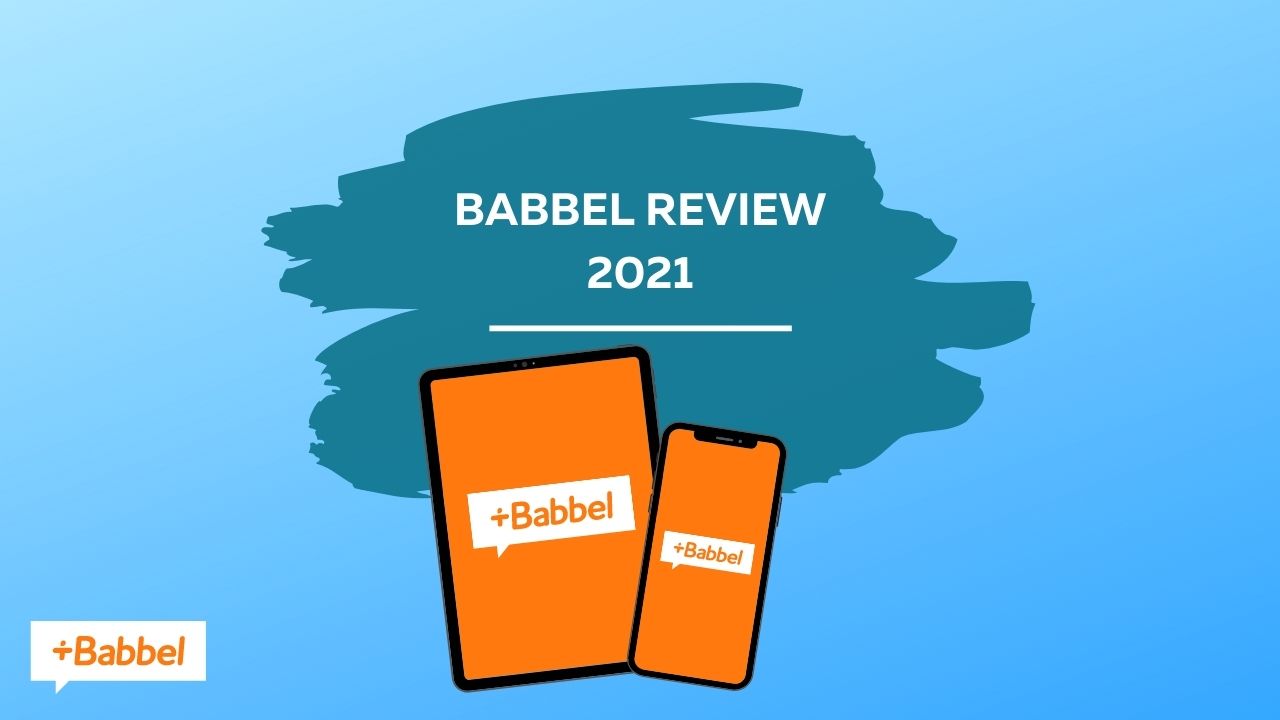
This article is a review of Babbel, an online resource for learning languages through audio and quiz-style lessons.
In this review, I'll take you inside the premium members area of Babbel and show you its main features, then share my honest assessment of the quality of the product, so you can decide whether it's right for you.
Babbel Review: Summary
The Good
- Very substantial content for Spanish and French
- Easy to use lesson format – audio lessons and handy mobile app
The Bad
- Too little content for most of the other languages
- Uninspiring exercises
The Cost
A premium Babbel subscription costs $83.40 per year.
The Verdict
Babbel is a good resource for learning vocabulary, everyday phrases and constructing basic sentences – especially for complete newcomers and beginners in a language.
If you’re learning Spanish or French, you can get a lot more out of it, as these courses take you to an advanced level.
Busy people with limited time for learning will appreciate the 15-minute lessons. If you battle with motivation and enjoy game apps, Babbel is a good introduction to your chosen language.
(My top recommendation for language learners is my Uncovered courses, which teach you through StoryLearning®. Click here to find out about Uncovered now.)
What Is Babbel?

Babbel is a popular online subscription-based language learning app. It’s a German company based in Berlin and has been around since 2007. It offers learners a choice of 13 popular languages, as well as English. The courses are interactive and the nearest equivalent is Duolingo.
Subscribers get access to an extensive library of audio lessons that follow a logical, linear progression from ‘newcomer’ to higher levels of fluency. Depending on which language you choose, there are also podcasts and the option of live lessons.
As long as you have a wifi connection, you can access all of the content through a web browser or a handy mobile app.
Babbel Review: A Look Inside Babbel
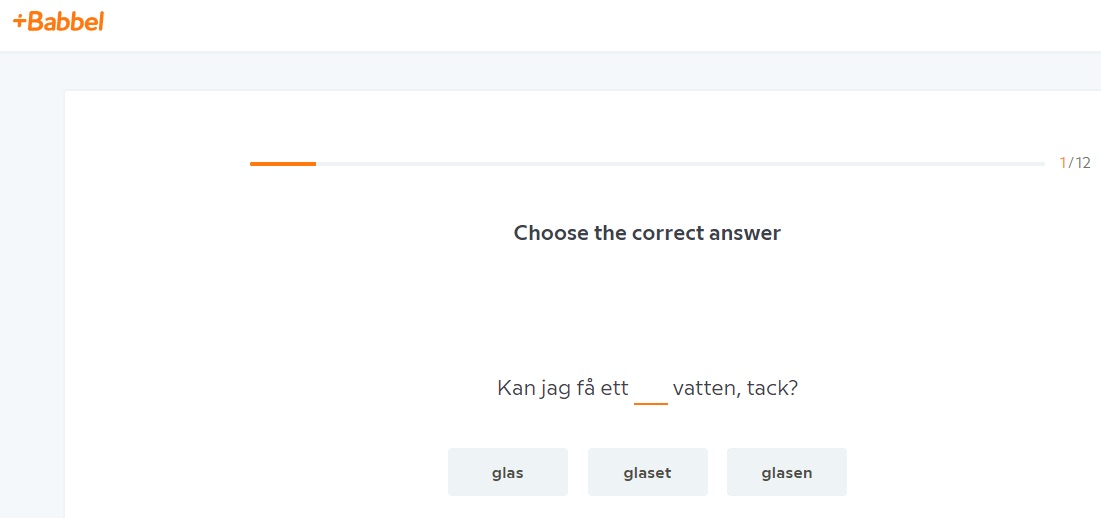
Lessons in Babbel are organised into 6 proficiency levels. Each level has 1 to 5 courses and within each course is a number of lessons – roughly 7 to 12.
The possible languages to choose from are: German, Spanish, French, Portuguese, Italian, Swedish, Danish, Norwegian, Dutch, Polish, Turkish, Indonesian, Russian and English.
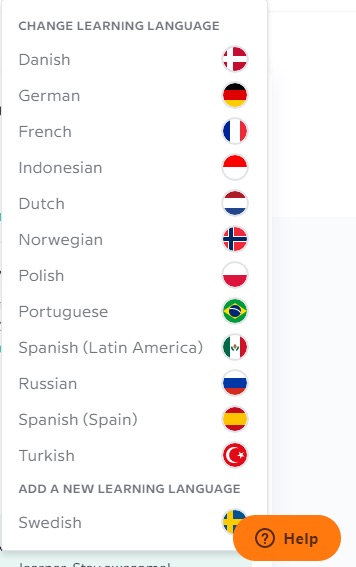
Each course follows a particular theme. For example, German beginners have this course: “Talking about your family, talking about birthdays, saying how old you are, numbers from 30 to 100.” And Italian pre-intermediate has this course: “Talking about your childhood, outdoor activities, an accident and when you’re not well.”
I find this organization helpful, because it gives you a clear idea of what you'll have learned by the end of the section.
Things get going with a placement test, which is handy if you don’t already know your level. You can then either follow from lesson to lesson, or choose which lessons you want to focus on. It’s easy to skip ahead if you find a particular lesson too easy for you.
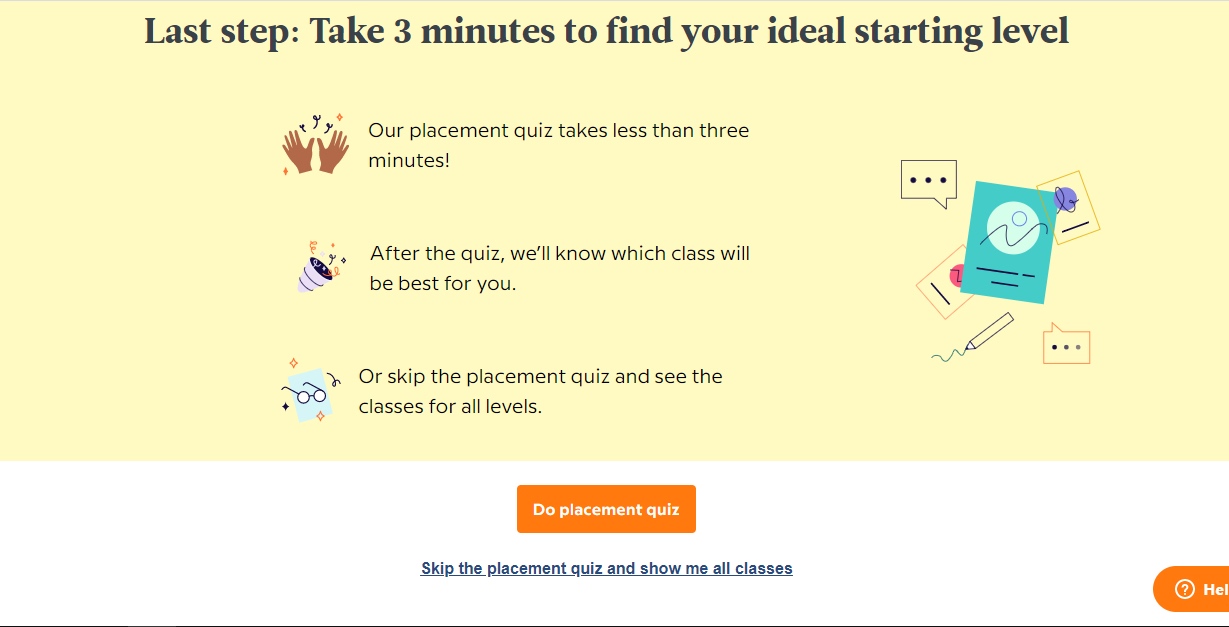
There is also an additional section with a few extra courses. These are based on specific skills and interests. Typical courses are: Refresher (for those who studied the language some time ago), Grammar, Listening and Speaking, Countries and Traditions, Words and Sentences, and Specials (idioms and so on.) German and Spanish each have a ‘Business’ course.
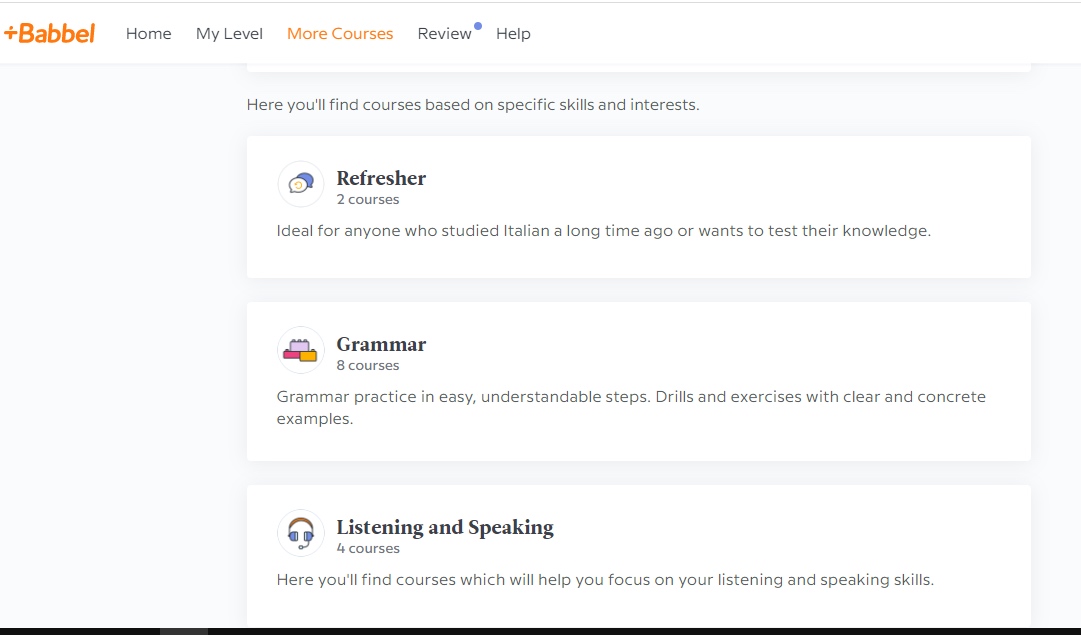
The downside is that only the top languages have all of these options.
What's Included In Each Lesson?
Each lesson contains …
- An interactive audio lesson
- An optional review section
Lessons generally follow this format:
- New vocabulary is introduced (with testing)
- The vocabulary is repeated in sentences or dialogues (with testing)
- Option to listen and repeat sentences with the voice recorder
- Once you answer correctly, you advance
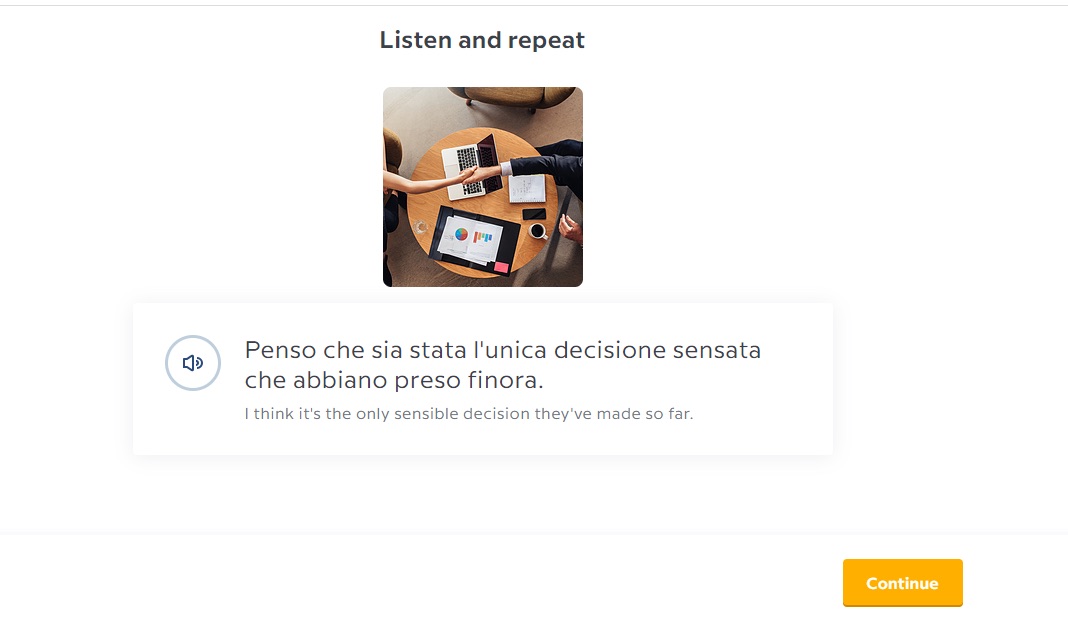
Once you've completed the main lesson, you can review in one of 4 ways:
1. Flashcards: These contain all of the vocabulary from completed lessons. Some have
individual words, others have full sentences.
2. Listening: Listen to a word or phrase and pick from multiple-choice answers.
3. Speaking: Listen to a phrase and repeat it with the voice recorder.
4. Writing: A ‘fill in the blanks’ exercise.

Looking Deeper At The Lessons…
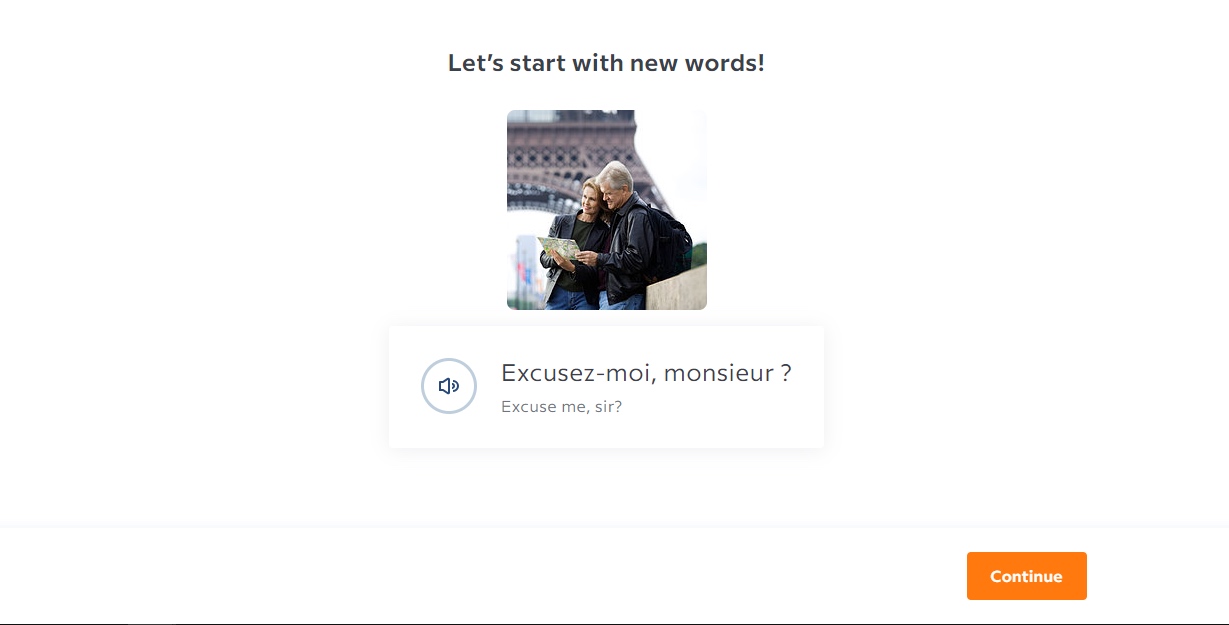
A native speaker (usually) presents information, and then a response is obligatory to move forward. You first learn simple phrases for beginners that are relevant and used in context, and then these get gradually harder.
For example, beginners in French learn phrases like “I don’t understand”; “Can you repeat, please?” I like the conversations with natural questions you’d actually ask. Great practical approach here that builds fluency naturally.
To be brutally honest, though, the interactive exercises are tedious… and unavoidable. On the plus side, they do challenge you to think. Babbel has also tried to make the learning experience fun, with helpful hints popping up when you’re stuck.
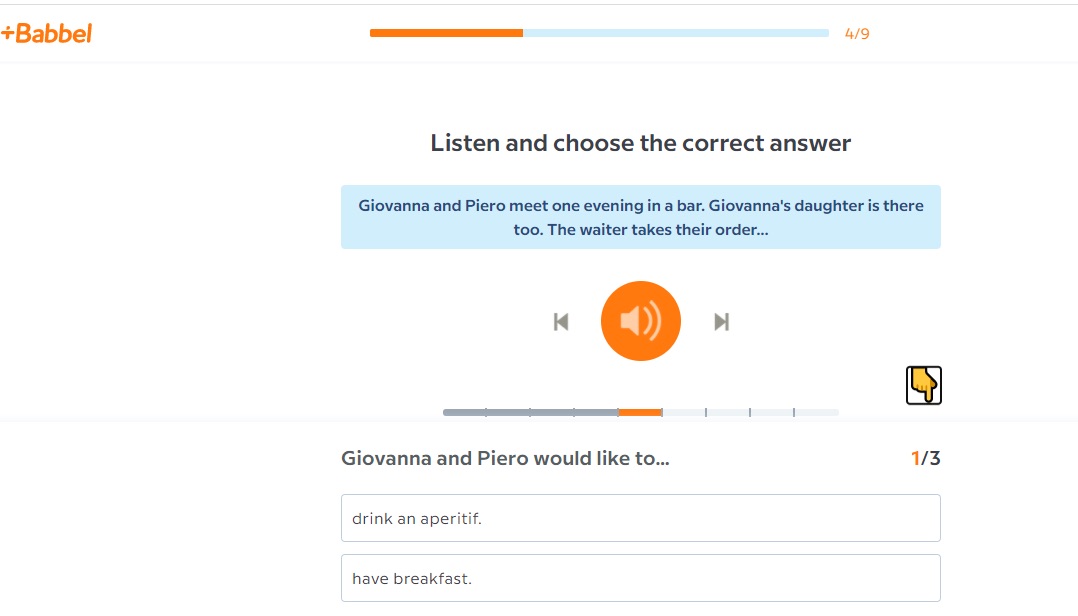
Certain languages give you helpful extras; for example, Italian has a video on hand gestures and Russian teaches the Cyrillic alphabet.
Much like flashcards, the review section is based on the method of spaced-repetition. Babbel calls this ‘Knowledge Levels’; the system remembers words and phrases that you get right, so they come up less often in review.
That said, I can’t see Babbel taking you all the way to fluency – no matter which language you choose. With all the input and output being entirely game-focused, you get no interaction with actual people and no immersive experience at all.
If you want to get fluent in a language, perhaps choose a more immersive, natural learning course and use Babbel as a supplement to keep building your vocabulary base.
Now let's take a look at some of the extra features of Babbel that you can find in some of the language courses…
Other Notable Features
If you’re taking a Spanish, French, German or Italian course, there’s a separate section where you can listen to podcasts. You need to first sign up for Apple Podcasts or Spotify to access them.
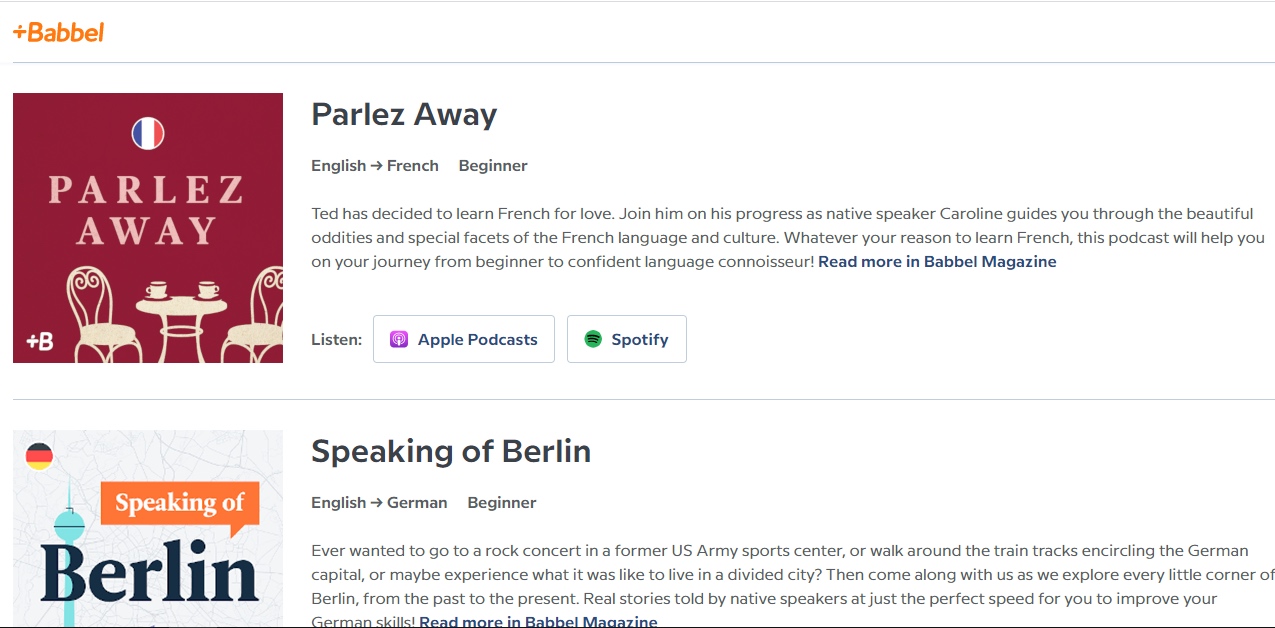
The podcasts usually have a few episodes each and you can listen to native speakers having conversations, speaking to English learners or telling short stories. Spanish also has a music playlist podcast designed to benefit beginners.
A small extra on the Spanish course is a fun section where you can play games like ‘Sink or Spell.’
Another useful feature is Babbel Live: online lessons with real teachers. What I like about this is that all of the teachers are certified and classes are small – a maximum of 6 learners at once. Unfortunately, this feature is only available on the Spanish, French and German courses! It’s also something you have to pay extra for. The most popular option is 10 classes a month, which costs 15 pounds per class.
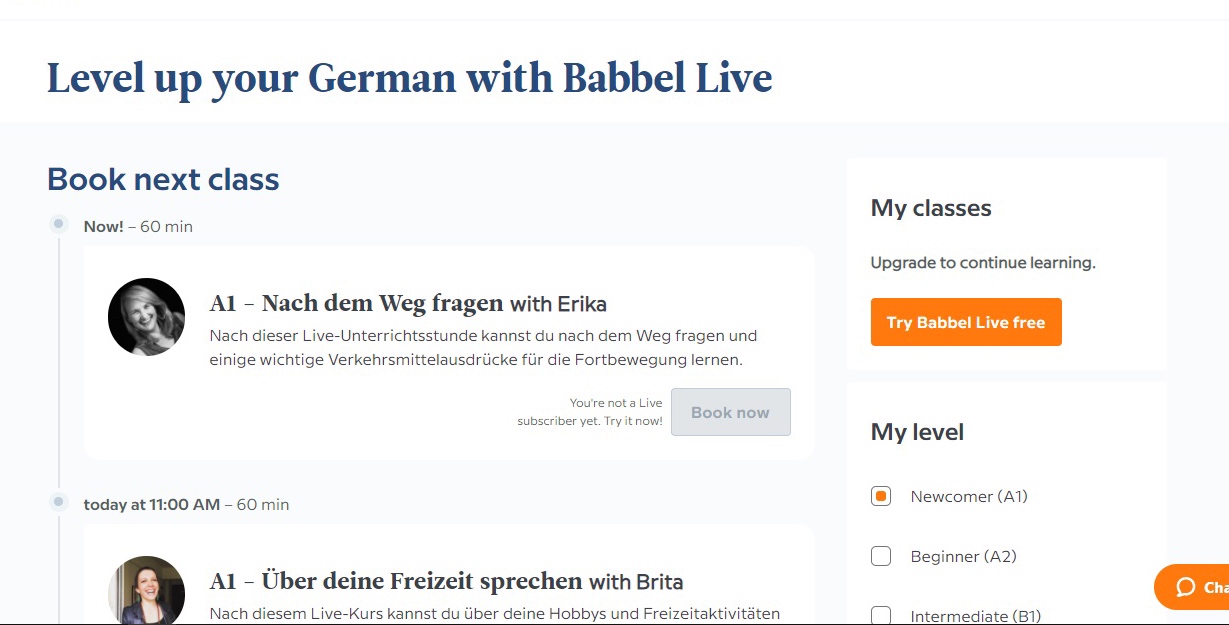
Babbel Review: What I Like
These things really stood out for me…
- The Spanish and French courses are well-designed: they’re immersive, with well-selected vocabulary and dialogues based on real-life situations. Lessons start off by introducing useful language, which is then put into interesting conversations that sound very natural – these are great! Overall, I found Italian to be a good and useful course, too.
- The difficulty levels are just right. Once you figure out your current level and get going, you'll find that the progression from level to level is logical, with a good flow from simple to challenging.
- Vocabulary is well-selected and based on everyday situations. This means the lessons teach useful language. Phrases are repeated often throughout a lesson and this repetition is very good for your memory.
- The ‘speaker’ option on individual lines is great! You can stop and listen to the audio again as many times as you want to before moving on. This is a very useful tool. It works especially well at higher levels, when you’re hearing long sentences.
- Awesome comprehension sections on the better courses. You listen to a dialogue and answer questions about what they were talking about. It forces you to think in the target language, as there’s no translation.
- Reinforced learning. You’re obligated to review what you learn as you go along, since you can’t advance until you get an answer right. This helps keep you focused, since you can’t give lazy answers! The extra review section at the end further supports this.
- The overall user experience is uncomplicated, with an easy to use interface.
- It’s affordable if you choose one of the courses with quality content.
- The handy mobile app makes it possible to do lessons easily on the go (although only when you’re able to concentrate, as it’s interactive.) It works well on Apple and Android devices and you can sync lessons across them all, which is super handy.
- The podcasts, which offer uninterrupted listening in the target language, are one of Babbel’s best features. There’s no better way to get a deeper connection to a language, than by simply hearing it. However, these podcasts are not part of the actual lessons and are only available in Spanish, French, German and Italian, which is a pity.
Babbel Review: What I Don't Like
In spite of the positives, there are also some significant downsides…
- Lesson distribution isn’t equal across levels. There are far more lessons for beginners and intermediate than for advanced learners. Most languages don’t even have an advanced section.
- No real immersion. One issue I have with the lessons is the fact that they seem entirely centered on vocab and grammar. This is definitely not an ideal, immersive experience. Language absorption is about spending as much time as possible with that language. I would love for there to be more material for extensive listening, so that you can get a real feel for the sound of the language.
- With the exception of Spanish and French, the courses won’t help you to get comfortable with making conversation in the real world. You don’t hear much natural interaction between people, and there’s no opportunity to speak or communicate. Bottom line: you’ll only go so far and then reach a plateau.
- The differences in quality and consistency across the languages is vast. You have a few languages with loads of content that clearly had a lot of time put into them, and then others that feel unfinished. For example, Indonesian only takes you to beginner level 2 and Russian only goes to Beginner 1.
- The interactive exercises are not much fun to do and make the lessons plod along at a slow pace, which is discouraging. I did not enjoy putting in so much effort with having to click things all the time; the multiple-choice, fill-in-the-blanks and matching words to images are a bit monotonous and uninspiring.
- Beginners will get frustrated with certain narrators. Some are fantastic, but others sound unnatural, or their speech isn’t always clear enough to make out what they’re saying. When you can’t hear syllables that are muffled or hurried-over, it means you also can’t advance, as you have to fill in the blanks correctly.
- Technical problems: The content is very often slow to load mid-lesson, and sometimes the ‘continue’ button doesn’t show up. A few times I had to close the lesson and start again.
- One price for both strong and weak courses. Considering the huge differences in quality across the languages, this is disappointing. It might be better to re-evaluate the pricing structure until the weaker courses have been brought up to par.
How Much Does Babbel Cost & Is It Worth It?
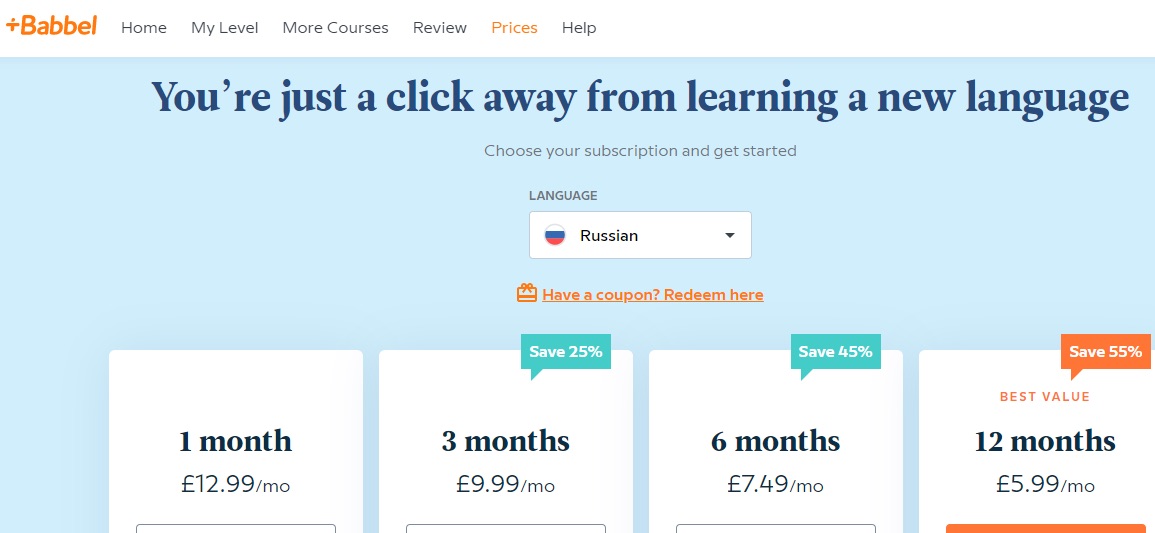
Babbel works on a freemium model – meaning it’s free to create an account and try out the first lesson. You can only do one free lesson per course.
There are various different subscriber options and as you might expect, the longer you subscribe for, the cheaper the deal. I find the prices quite reasonable. If you’re not happy, you have 20 days to ask for your money back.
If you take a one-year premium subscription as our baseline – this costs $83.40. That's substantially less than other commercial products like, say, Rosetta Stone ($399) or Pimsleur ($345 for 30 lessons). On the other hand, the app most like Babbel – Duolingo – is free (although Babbel is much better!)
Overall, I think Babbel is an exciting resource for convenient foundational learning and, despite my issues with the content, I think you'll find it useful if you decide to sign up.
However, if you're looking for a comprehensive beginner programme that will take you all the way to the intermediate level in your language of choice, and that uses a much more fun, engaging and effective method, then I've got something that might suit you better…
StoryLearning: A Better Alternative To Babbel
While Babbel is reasonably well-structured and has some fun quiz-style content, it’s not the most exciting, immersive language learning app.
That's where Uncovered is different.
Uncovered is a comprehensive online beginner course that takes you from a complete beginner in a language, up to an intermediate level. And it's fuelled by a fun and unique method called StoryLearning®.
StoryLearning is a process that was invented to teach you languages naturally. It’s so natural, in fact, that it’s based on how human beings learn their native language.
In the course, you'll learn through an exciting original story in your language of choice, written especially for beginner learners. Every word is intentional, designed for optimal learning to take place.
Though you learn through story, you also have a teacher and experienced language learner by your side all the way through the course. She offers support with explanations in English and tips to help you learn the material fast.
Uncovered teaches all of the key aspects of the language: reading, listening, vocabulary, grammar, pronunciation and speaking. So by the time you've finished, you'll be a confident intermediate level language speaker, ready to go out and actually use your new language in the real world!
What You Get With Uncovered

- Complete 20-module course to learn to speak your new language with confidence through StoryLearning™. This is a method that relies on your brain's natural way of learning.
- 80+ video lessons with your experienced language teacher. You'll learn with the same method that's attracted worldwide attention, from the BBC, Independent, Open University, European Commission, El País, and more!
- Learn the secrets I used to learn 8 languages and how to use them yourself to learn to speak with confidence & take part fully in conversations with native speakers.
- Fully downloadable programme so you can learn faster – anywhere, any time, and on any device… even without an internet connection!
- Complete learning material, including audiobook, translations, printable worksheets… everything you need to get started and find success with your language learning!
- Expert pronunciation training videos, so you can perfect your pronunciation and speak like a native from the start.
- Money-back guarantee, so you can buy without risk today, and get a full refund if you don't love it.
If you're determined to learn a language and looking for the most fun and effective language course around, I'm confident you'll love Uncovered!
Ready to start? Click here to find out more about Uncovered and start your language learning journey.

Olly Richards
Creator of the StoryLearning® Method
Olly Richards is a renowned polyglot and language learning expert with over 15 years of experience teaching millions through his innovative StoryLearning® method. He is the creator of StoryLearning, one of the world's largest language learning blogs with 500,000+ monthly readers.
Olly has authored 30+ language learning books and courses, including the bestselling "Short Stories" series published by Teach Yourself.
When not developing new teaching methods, Richards practices what he preaches—he speaks 8 languages fluently and continues learning new ones through his own methodology.








































